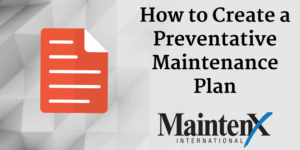
Preventive maintenance may seem simple, but if you don’t plan properly, it can be a waste of your time and resources. The tips below will start you down the path toward effective, efficient, and simple preventive maintenance for your facility.
Know Which Assets Require Maintenance
Assets that can benefit from preventive maintenance include those that:
- have an important operational function
- run frequently or constantly
- become more likely to fail over time
Advantages of Preventative Maintenance
Planning is the principal element of a thorough preventative maintenance program. Reactive maintenance comes with a big price tag and can be easily avoided. The costs associated with unplanned maintenance include:
- budgetary strain from unplanned service
- higher costs for parts and shipping
- time lost responding to emergencies
- lowered productivity while equipment is not working
Unplanned maintenance can cost three to nine times more than preventative maintenance. When maintenance is planned, each of these costs can be reduced. In addition, it improves safety by reducing the likelihood of dangerous equipment failure.
Create an Inventory List
Before you can determine which pieces of equipment you need to maintain, you need to create a comprehensive inventory of what needs to be included in your preventative maintenance plan. This list should then be ordered by priority. Though preventative maintenance is appropriate for most major systems, some need it more frequently than others.
Your inventory should include the following information for each piece of equipment:
- Make and model
- Specifications and capabilities
- Asset number (the internal identifier or unit number for your company’s system)
- Serial number
- Category of the equipment (HVAC, plumbing, electrical, etc.)
- The physical location of the equipment in your facility
- The department responsible for the asset
- Item purchase cost
- Internal or external maintenance service responsible for its service
- The date the maintenance is due
- The last time it was serviced and any previous issues serviced on the asset
Want to know more about preventative maintenance? Call the maintenance professionals at MaintenX!

